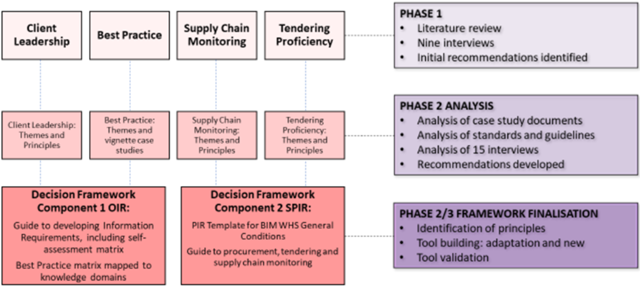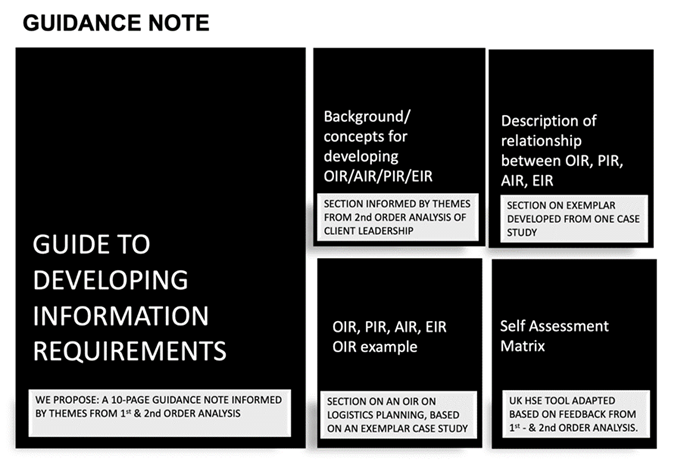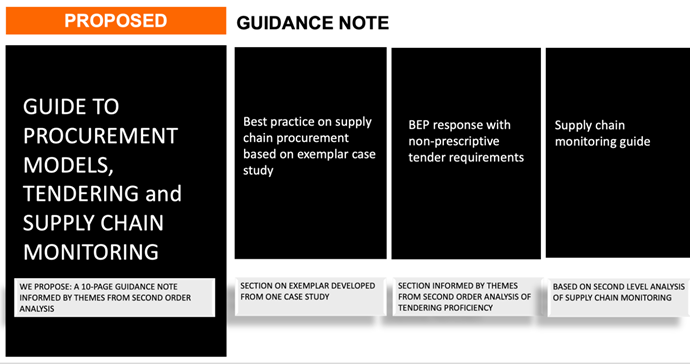Health and safety management using building information modelling: Phase Two Report
Executive summary
Background
The construction industry is infamous for having a high number of fatalities around the world. The use of Building Information Modelling (BIM) has been considered an influential way to improve Work Health and Safety (WHS) outcomes by improving communication, information flow and risk analysis in all phases of an asset’s lifecycle. The research “Work Health and Safety Management using Building Information Modelling” is a four-phase study aiming to examine the opportunities to achieve WHS objectives through the application of BIM in major construction projects. This Technical Report presents the outcomes of Phase 2, including the results of an in-depth empirical study and the recommended contents of a Decision Framework. The proposed Decision Framework will support pathways for clients and project team leaders to collaboratively work together and develop high-quality information requirements that clarifies the data management environment expectations for all stakeholders. The tools underpinning the Decision Framework will support the development of high-quality criteria for tendering, evaluation and monitoring, and ultimately, the delivery performance of the primary contract throughout the supply chain.
Method
Data was gathered from five sources: 1) Australian and international BIM standards, frameworks and guidelines; 2) Existing tools and templates informing the adoption of BIM for WHS management, 3) Project documents from three real-life case study projects in New South Wales (NSW), Australia; 4) 12 interviews with participants involved in the case studies; and 5) Interviews with two Australian government clients and a UK-based BIM for WHS management expert. The five data sources were analysed in the following sequence:
- Document analysis. An in-depth analysis of standards, guidelines and frameworks provided a scaffold for organising project documents and for discerning threads of BIM for WHS management in the three case studies.
- Level-1 and Level-2 interview analysis. Two levels of analysis were conducted of the interview transcripts. Level-1 involved the identification of participant-driven thematic codes, while Level-2 identified researcher-driven axial codes.
- Decision Framework development. A knowledge translation process began mid-way through the Level-1 analysis and was iteratively refined throughout Phase 2. Level-2 themes informed the development of principles and tools for the Decision Framework.
Results
The document analysis identified preliminary areas of strength and areas of improvement in specifying for BIM for WHS management. While the documents provided an important foundation for developing interview strategies, the findings were considered preliminary because they did not provide a comprehensive analysis of the case studies nor a substantial foundation for tool building.
The Level-1 analysis was developed based on participant interviews from the three Case Studies. Themes from four sample interviews were additionally mapped to the six WHS Knowledge Domains for BIM-WHS integration (KDs) identified in Phase 1 (i.e., Scenario planning, Requirement briefing, Risk assessment, Education and training, Monitoring and surveillance, and Reporting and analysis). Data from sample interview 1 and 2 (Case Study 1) showed multiple examples of best practice in each of the six KDs. Data from sample interview 3 (Case Study 2) showed examples of best practice in all KDs, except Reporting and Analysis, while data from sample interview 4 (Case Study 3) included examples of best practice in all KDs, except Education and Training, and Monitoring and Surveillance.
The core result of the Level-2 analysis was the identification of themes and theme groups underpinning each of the four recommendation areas of investigation identified in Phase 1 (i.e., Client Leadership, Tendering Proficiency, Best Practice and Supply Chain Monitoring).
Client Leadership was linked to a total of 163 units of text, categorised into eight themes. The themes clustered into three theme groups that resonated with all six Knowledge Domains. The themes pointed to three specific directions for the emerging Decision Framework: 1) Emerging content for Client Leadership that would help to improve awareness and understanding of how critical clients and the project leadership group are to the integration of BIM WHS management adoption, 2) Emerging roadmap for Client Leadership in BIM for WHS management, and 3) initial considerations, mindsets, drivers and data management environment for Client Leadership in BIM for WHS management.
A total of 159 units of text were linked to Tendering Proficiency and also categorised into eight themes and three theme groups. The theme groups and themes resonated with all six KDs and will feed into the components of the Decision Framework that relates to 1) the development of information requirements and 2) guidance on procurement and tendering.
Supply Chain Monitoring was linked to 102 units of text, categorised into seven themes. The themes clustered into three theme groups that resonated with all Knowledge Domains except Scenario planning. The theme groups and themes indicate that contractual requirements could be designed to ensure the supply chain shifts to BIM-supported WHS management. These insights will inform guidance on supply chain monitoring within the Decision Framework.
A total of 178 units of text were linked to Best Practice, categorised into eight themes. The themes clustered into three theme groups that also resonated with all six Knowledge Domains. The Theme groups and themes under Best Practice will support the Decision Framework by providing examples, mini case studies and quotes of best-practice BIM-WHS integration.
Discussion
Phase 2 aimed to validate the Phase 1 recommended areas of investigation and use them as a platform for tool-building. A multi-stage analysis of qualitative data led to the development of the detail in the proposed Decision Framework.
Level-1 analysis findings suggest that exemplars of BIM for WHS management can already be found in three of the six Knowledge Domain: namely Scenario planning, Risk assessment and Requirement briefing. However, BIM adoption for WHS management remains largely underexplored in the other three Knowledge Domains. BIM appears not to be used in a formal manner to educate and train supply chain actors about better WHS management. The use of BIM for directly monitoring WHS management also did not emerge in any of the case studies. There are exemplars that were identified in Phase 1 and which the Decision Framework shall draw upon.
The Level-2 analysis led to the identification of clear lessons as well as areas that remain open for further exploration and debate across the four areas of investigation. The themes within Client Leadership suggest that four elements are critical to mature adoption of BIM for WHS management: 1) commitment to the centrality of integrated high-quality data to the organisations’ asset management and capital works procurement strategies, 2) robust WHS management processes 3) explicit use of technology, and 4) the development of formal and informal strategies to achieve collaboration and compliance across the supply chain. The themes within Tendering Proficiency suggest that Tendering Proficiency emerges from Client Leadership, specifically in the client’s ability to build a team and maintain it through broad and ongoing engagement as well as through sound communication strategies in pre-award/tender assessment and post award. The Supply Chain Monitoring themes, combined with Level-1 results, suggest that BIM has not been used extensively for monitoring WHS, although possibilities and directions are emerging, particularly in Case Study 3. The critical enabling role of clients and the lack of clear direction supports our contention that clients need guidance on how to make decisions suitable to their own needs and circumstances in a complex and emerging environment. Finally, the Best Practice themes suggest that ‘Best Practice’ as an area of recommendation overlaps with the previous recommendation areas however is useful to highlight explicitly examples to support principles in the Framework. An explicit map of Phase 1 Recommendations against the Phase 2 findings and the Decision Framework is provided in the Discussion section of the report.
Key recommendations for the Decision Framework
Further exploration of the four recommendation areas informed the design of the proposed Decision Framework, comprising two main components and four sub-components as indicated in the following figure.

The first component (Guide to Developing Organisational Information Requirements) will be focussing on assisting clients in how to show leadership and develop Information Requirements and the second component (Guide to Developing Strategic Project Information Requirements) will assist clients in developing Information Requirements at a project level. Although the study began in early 2020 it is important to note that the Decision Framework is aligned with the recently released NSW Infrastructure Data Management Framework, particularly in relation to terminology, agency information requirements, and the types of models and their interrelationships.
The Guide to Developing Information Requirements will have two subcomponents, including 1a: a guide for clients (and project leaders) towards developing information requirements containing a client BIM for WHS management Self-Assessment Matrix (an adaptation of an existing Matrix from the UK), and 1b: a suite of best practice examples across the six Knowledge Domains. The second component supports the development of strategic project information requirements (SPIR). A SPIR is required to assure consideration is given to planning, design, construction and operation phases with respect to data being captured and structured consistently and securely in a reusable, accurate, integrated and standardised manner. The SPIR will have two subcomponents, including 2a: a guide note to support procurement, tendering, and supply chain monitoring, and 2b: an example of general conditions for inclusion at tender (an adaptation of an existing UK BIM for WHS management general conditions). The direction for Phase 3 is to draft and evaluate the two main components and four sub-components for the proposed Decision Framework.


